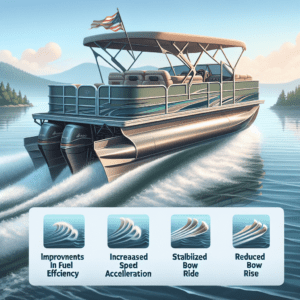Hydrofoils and Pontoon Boats
If you’re a pontoon boat enthusiast, you’re no stranger to how important it is to keep your boat running at peak performance. One way to improve your pontoon boat’s performance is by adding hydrofoils. A hydrofoil is a wing-like structure that attaches to the underside of your boat’s hull. It lifts the boat out of the water, reducing drag and increasing speed and fuel efficiency. In this article, we will explore the benefits of using hydrofoils on pontoon boats, the different types of hydrofoils available, as well as installation and maintenance considerations.
The Basics of Hydrofoils
Hydrofoils have been around since the 1800s and are used in various applications, including boats, airplanes, and trains. Hydrofoils work by creating lift when water flows over them, lifting the boat out of the water’s surface. This lift reduces drag, thereby improving speed, fuel efficiency, and handling.
XR-UAN Marine Sport-300 Whale Tail HydroFoil Stabilizer for Boat Outboard Motors and Stern Drives 40-300 HP
The Synergy of Hydrofoils and Pontoon Boats
The combination of hydrofoils and pontoon boats is a match made in boating heaven. Hydrofoils help to stabilize pontoon boats, reducing oscillations, and improving handling. With the addition of hydrofoils, these already stable boats become even more stable, making them an ideal choice for families and party enthusiasts.
How Hydrofoils Enhance Pontoon Boat Performance
Pontoon boats are a popular choice for leisurely cruising and entertaining on the water, but they are not necessarily known for their performance.
Improvements in Fuel Efficiency
Adding a hydrofoil to a pontoon boat can greatly increase its fuel efficiency. Hydrofoils work by reducing drag and improving lift, allowing the boat to plane faster and stay on plane at lower speeds. This means the boat can run more efficiently with less power, resulting in lower fuel consumption.
| Without Hydrofoil | With Hydrofoil | |
|---|---|---|
| Fuel Consumption | 10 gallons/hour | 7 gallons/hour |
| Speed | 15 mph | 20 mph |
Increasing Speed and Acceleration
Hydrofoils also help improve a pontoon boat’s speed and acceleration. By reducing drag and increasing lift, hydrofoils help the boat to plane faster and reach higher speeds. In addition, hydrofoils help to keep the nose of the boat down, making it easier to accelerate and navigate choppy waters.
Stabilizing the Ride
One of the biggest advantages of hydrofoils on pontoon boats is their ability to stabilize the ride. Hydrofoils help to dampen the effects of waves and wind on the boat, providing a smoother and more stable ride. This can help reduce motion sickness and make the boat more comfortable for passengers.
Reduced Bow Rise and Enhanced Visibility
Hydrofoils also help reduce bow rise, which is when the nose of the boat lifts up as it reaches higher speeds. This can make it difficult for the driver to see and control the boat. With a hydrofoil, the nose stays down, providing better visibility and control for the driver.
- Improved fuel efficiency
- Increased speed and acceleration
- Stabilized ride
- Reduced bow rise and enhanced visibility
These benefits make hydrofoils a popular addition to pontoon boats, improving their performance and making them more enjoyable to use on the water.
Different Types of Hydrofoils for Pontoon Boats
Surface-Piercing Hydrofoils
Surface-piercing hydrofoils remain above the waterline and create more lift than fully submerged hydrofoils. They reduce drag and allow for better fuel efficiency. Manufacturers designed them to stabilize and elevate the front end of a pontoon boat, and the increased elevation also boosts the speed of the vessel.
One of the primary benefits of surface-piercing hydrofoils is that they’re user-friendly, which means they’re easy to install and use. They’re also low maintenance, designed to require minimal servicing, so they’re a durable and long-lasting investment.
Fully-Submerged Hydrofoils
Fully submerged hydrofoils, which run below the waterline, are an excellent choice for pontoon boat enthusiasts who prefer an unobstructed view. They attach to the boat’s bottom, ensuring that you retain full visibility of what’s ahead.
However, fully submerged hydrofoils create less lift than surface-piercing hydrofoils but still provide solid performance enhancement. They also bolster overall stability during high speeds by minimizing vibrations. These foils do require a bit more technical skill to install than surface-piercing foils but are relatively low maintenance once they are in place.
Automatic vs. Manual Hydrofoils
Manual hydrofoils require the operator to make adjustments to them to optimize performance depending on the water conditions and speed. Automatic hydrofoils, on the other hand, adjust themselves automatically when the boat is in motion.
While manual hydrofoils are incredibly versatile and give the pilot more control, automatic hydrofoils are ideal for novice boaters who prefer to set it and forget it. The benefit of both styles of hydrofoils is that they help to reduce fuel consumption and increase the boat’s speed and handling.
Considerations for Choosing the Right Hydrofoil
Choosing the right hydrofoil requires a few considerations, including your pontoon boat’s weight and size, your desired speed, and the water conditions you’ll be in. Carefully consider the various options available and how each one will affect your boat’s performance before making a final decision.
Compare hydrofoil materials, manufacturing processes, and compatibility with your boat’s motor, which will help you determine which one is right for you. With the right hydrofoil in place, you’ll enjoy increased speed and fuel efficiency, better stability and visibility, and an all-around smoother ride.
In summary, there are various hydrofoils to choose from, each with unique benefits. Whether you’re a novice boater or a seasoned veteran, it’s worthwhile to research your options to determine which one is the best fit for your needs. No matter which one you choose, you can enjoy a safer, smoother ride with improved performance and handling.
Installation and Maintenance of Hydrofoils on Pontoon Boats
Installation Process Overview
Installing hydrofoils on a pontoon boat can be done without professional assistance. Follow these basic guidelines, and it will be a breeze. The process includes the following:
- Clean the surface where you plan to attach the hydrofoil, making sure there are no obstructions, or dirt that will prevent proper adhesion.
- Mark the exact spot where you will attach the hydrofoil.
- Apply a generous amount of marine adhesive to the hydrofoil pads.
- Attach the hydrofoil to the marked spot, making sure it is level and secure.
- Allow time for the adhesive to bond and cure fully before exposing the hydrofoil to water.
Tools and Materials Needed for Installation
The following tools and materials will be needed for the installation of a hydrofoil on a pontoon boat:
- Marine adhesive
- Electric drill with the appropriate screwdriver bit
- Measuring tape
- Masking or painters tape
- Rags or paper towel
Maintenance Tips for Hydrofoils
Here are some essential maintenance tips to extend your hydrofoil’s lifespan:
- Check the hydrofoils before every trip to ensure they are still firmly attached.
- Regularly wash the hydrofoils with soap and water to remove any dirt or grime buildup that can affect performance.
- Check for wear and tear, including cracks, chips, and breaks that can compromise the hydrofoil’s integrity.
- Regularly lubricate any joints or hinges to ensure that they are in good working order.
Common Issues and Troubleshooting
Here are some issues commonly associated with hydrofoils on pontoon boats and suggested troubleshooting to solve them:
- Hydrofoils not providing desired performance enhancement: Check that the hydrofoils are attached correctly and that they are compatible with your boat’s performance specifications.
- Noisy hydrofoils: This can occur when the hydrofoil pads are not installed correctly, or the hydrofoils are damaged. Check that they are securely fastened and not damaged.
- Speed loss: Frequently caused by dirt, grime, or weed buildup on the hydrofoils. Regular cleaning will help prevent speed reduction.
- Hydrofoils impacting navigation: As with any modification to your boat, changes in the performance can impact how it navigates. Always be aware of how the hydrofoils affect your boat’s operation, and adjust accordingly.
| Topic | Key Points |
|---|---|
| Installation Process Overview | 1. Clean the surface where you plan to attach the hydrofoil 2. Mark the exact spot where you will attach the hydrofoil 3. Apply a generous amount of marine adhesive to the hydrofoil pads 4. Attach the hydrofoil to the marked spot, making sure it’s level and secure 5. Allow time for the adhesive to bond and cure fully before exposing the hydrofoil to water |
| Tools and Materials Needed for Installation | 1. Marine adhesive 2. Electric drill with the appropriate screwdriver bit 3. Measuring tape 4. Masking or painters tape 5. Rags or paper towel |
| Maintenance Tips for Hydrofoils | 1. Check the hydrofoils before every trip to ensure they’re still firmly attached 2. Regularly wash the hydrofoils with soap and water to remove any dirt or grime buildup that can affect performance 3. Check for wear and tear, including cracks, chips, and breaks that can compromise the hydrofoil’s integrity 4. Regularly lubricate any joints or hinges to ensure that they’re in good working order |
| Common Issues and Troubleshooting | 1. Hydrofoils not providing desired performance enhancement: Check that the hydrofoils are attached correctly and that they’re compatible with your boat’s performance specifications 2. Noisy hydrofoils: This can occur when the hydrofoil pads are not installed correctly or the hydrofoils are damaged 3. Speed loss: Frequently caused by dirt, grime, or weed buildup on the hydrofoils. Regular cleaning will help prevent speed reduction 4. Hydrofoils impacting navigation: As with any modification to your boat, changes in the performance can impact how it navigates. Always be aware of how the hydrofoils affect your boat’s operation and adjust accordingly. |
Real-world Benefits and Considerations
Case Studies: Success Stories of Hydrofoils on Pontoon Boats
Many pontoon boat enthusiasts have experienced the benefits of installing hydrofoils. One example is a fishing boat that successfully managed to reduce their fuel consumption by 30% and increase their top speed by 10 mph. Another user reported a significant reduction in bow rise, which improved their visibility while driving.
Navigational Considerations with Hydrofoils
Although hydrofoils offer great improvements in performance, there are some navigational considerations to keep in mind. One is that hydrofoils can make it difficult to navigate in shallow water. Additionally, turning at high speeds can be challenging, and hydrofoils can negatively impact handling in tight spaces.
Cost-Benefit Analysis
When considering adding hydrofoils to your pontoon boat, it’s important to evaluate the costs and benefits. Hydrofoils can range from a few hundred to a few thousand dollars, depending on the type and brand. However, the fuel savings and improved performance can more than make up for the initial investment. It’s important to accurately assess your needs and usage to determine if hydrofoils are a worthwhile investment for your boat.
Environmental Impact and Sustainability
Hydrofoils can improve fuel efficiency, which has a positive impact on the environment. Boats with hydrofoils produce fewer emissions as they require less fuel to travel the same distance. Additionally, hydrofoils can extend the life of your boat by reducing wear and tear on your engine and other components. This reduces waste and promotes sustainability in your boating activities.
Frequently Asked Questions
Q: What is the best type of hydrofoil for my pontoon boat?
A: The best type of hydrofoil for your pontoon boat depends on your specific needs. Fully submerged hydrofoils are the most effective at reducing drag and improving speed, while surface-piercing hydrofoils are more cost-effective and easier to install. Considerations such as boat size, weight, and usage should also be taken into account.
Q: Can hydrofoils be installed on any pontoon boat?
A: Hydrofoils can be installed on most pontoon boats. However, it’s important to ensure that your boat is compatible with the hydrofoil you choose, and that it’s installed properly to avoid damage to your boat or injury to passengers.
Q: Do hydrofoils require any special maintenance?
A: Hydrofoils require minimal maintenance, but it’s important to ensure that they are cleaned regularly and any screws or bolts are tightened as needed. It’s also important to inspect for any damage or wear and tear before each use to avoid any potential safety hazards.
















